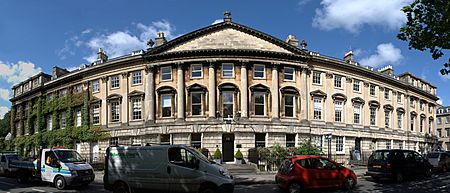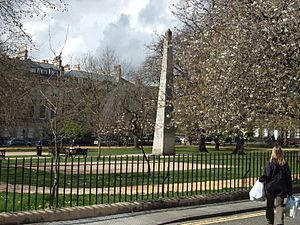Queen Square, Bath facts for kids
Queen Square is a beautiful square of Georgian-style houses in the city of Bath, England. It's the first part of a famous line of buildings in Bath that also includes the Circus and the Royal Crescent. All the buildings in Queen Square are very important and are protected as Grade I listed buildings.
The square was first built in the early 1700s by an architect named John Wood, the Elder. He designed the fronts of the buildings to follow a style called Palladian architecture, which was popular at the time. Then, he let other builders finish the rest of the houses. The tall stone pillar (called an obelisk) in the middle of the square was put there in 1738 by Beau Nash to honor Frederick, Prince of Wales.
During World War II, some buildings on the south side of the square were damaged by bombs. After being repaired, many of the buildings are now offices. The west side is home to the Bath Royal Literary and Scientific Institution, and the south side has the Francis Hotel.
Contents
How Queen Square Began
Queen Square was the first big building project by the architect John Wood, the Elder. He later lived in one of the houses on the square himself.
Wood wanted to make Bath a very important city again, like he believed it once was. In 1725, he started planning how to improve the city by building new areas.
Wood had big plans for Bath, but he often faced problems from the city council and other important people. Instead, he worked with Robert Gay, who owned land outside the city walls. On this land, Wood created the building style that Bath became famous for. Many architects who came after him copied his ideas.
Building the Square
John Wood introduced a new way of building in Bath called "speculative building" at Queen Square. This meant that Wood rented the land and designed the building fronts. He then divided the land into smaller plots for other builders to work on.
These builders had two years to put up the walls and the roof. After that, they had to pay more rent. Because Bath was growing fast, most plots were claimed quickly. This helped the builders get the money they needed to finish the houses. This method meant less work and risk for Wood, and he made a good profit from the rents.
The Obelisk
The tall stone pillar, or obelisk, in the middle of Queen Square was something Wood was very proud of. Beau Nash put it there in 1738 to honor Frederick, Prince of Wales. It used to be about 70 feet tall and stood in a round pool. But a strong storm in 1815 broke off its top part.
History of the Square
John Wood chose to live at No. 9 on the south side of Queen Square until he passed away. This house is now the entrance to the Francis Hotel. From his home, he had a perfect view of the square, including the obelisk and the grand buildings on the north side.
Even though it was outside the city walls, Queen Square quickly became a popular place for people in Bath's Georgian society to live. It was away from the busy, old streets of Bath. Yet, it was still only a short walk to important places like Bath Abbey, the Pump Room, the Assembly Rooms, and the famous baths.
To the north, Wood's building vision continued with Gay Street, where writer Jane Austen once lived. Then came the Circus, where artist Thomas Gainsborough made his home. Finally, the path led along Brock Street to the famous Royal Crescent.
World War II Damage
During World War II, Bath was attacked by German planes in April 1942. These attacks were part of a campaign called the Baedeker Blitz. Over 400 people were killed in Bath, and more than 19,000 buildings were damaged or destroyed.
During one of these raids, a powerful bomb landed near the east side of Queen Square. This caused damage to houses on the south side. The Francis Hotel lost about 24 meters of its front, and most buildings in the square had some damage from flying debris. Luckily, not many people were hurt in the square because most hotel guests and staff had gone to the hotel's basement for safety.
The buildings have all been repaired since then, but you can still see some small signs of the bombing if you look closely.
Queen Square Today
All the buildings in Queen Square are protected as Grade I listed buildings by Historic England. This means they are very important and must be preserved.
Numbers 16–18 are now used by the Bath Royal Literary and Scientific Institution (BRLSI). The south side, which was once open, is now home to the 4-star Francis Hotel.
The square often hosts fun events throughout the year. These include French and Italian markets, and even a weekend for playing the game of boules.
In 2011, the square was used by protesters as part of the global Occupy movement. People set up tents and held discussions, talks, and music events about financial fairness. The protest camp stayed for about six weeks before it was taken down.
Images for kids




